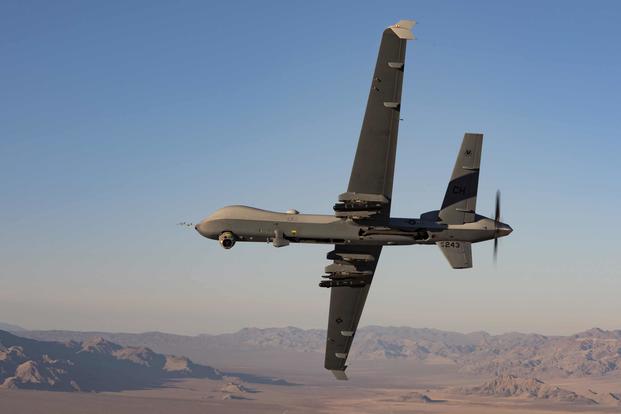The MQ-9 Reaper has been the U.S. Air Force's hunter-killer drone for more than a decade, but it simply isn't suited to the high-end fight the service is preparing for, according to a top official.
The service is expected to lay out details for its replacement plan in its fiscal 2022 budget.
"The Reaper has been a great platform for us," Dr. Will Roper, assistant secretary of the Air Force for acquisition, technology and logistics, told lawmakers Tuesday.
"Four million flight hours of just undeniable overmatch in a low-end, uncontested fight and [it] has certainly saved many lives," he said before the House Armed Services subcommittee on tactical air and land forces.
"But as we look to the high-end fight, we just can't take them into the battlefield. They are easily shot down, and so what we are preparing to do on the acquisition side as we take down the production line is build the next generation of systems," Roper said.
Related: Air Force to Send More than 100 Planes to Boneyard as it Invests in Future Fighters
In August, unnamed U.S. defense officials confirmed to Reuters that a U.S. MQ-9 was shot down over Yemen by Iran-backed Houthi rebel fighters. Months earlier on June 6, U.S. Central Command confirmed another Reaper had been shot down by Houthis, with Iranian assistance.
Roper said the Air Force is conducting studies to develop unmanned attack aircraft that are intended to be reusable, but cheap enough that they can be destroyed without significant loss. It is also looking at how those technologies compare with more expensive systems that can survive in extreme situations.
"It's a big [business] market right now -- many commercial applications, and so we will look at a mixture of options for the future," he said. "There are things that are more high-end military unique, things that are meant to be able to survive even in a contested environment. A lot of technology will have to go in[to that] and there will likely be expensive systems, but we also see a lot of opportunity to bring in commercial technology, push the price point down, have systems that ... we can take more loss with."
In 2017, commanders began expanding the mission set of the larger, faster MQ-9 as the Air Force began phasing out its unmanned cousin, the MQ-1 Predator. That year, officials verified through a controlled test that the MQ-9 had bagged its first air-to-air kill of another small, aerial vehicle, showing it had the ability to conduct air-to-air combat. The MQ-1 officially retired in 2018.
The Air Force revealed through its fiscal 2021 budget submission it plans to buy its final 24 Reapers this year, which would cut the total buy to 337 aircraft instead of the planned 363, Air Force Magazine reported last month.
The decision surprised the drone's maker, General Atomics, the magazine said. Chris Pehrson, General Atomics' vice president of strategic development, said a premature end to the production line could lead to gaps in global operations.
"The abrupt shutdown of the production line without a transition plan does jeopardize the [intelligence, surveillance and reconnaissance] enterprise," Pehrson told the magazine. "You'll see impact eventually, when combat lines have to be reduced or ... the assets aren't there for training."
The details come as top commanders in Africa and the Middle East have raised similar concerns about the MQ-9, saying that more ISR is needed given militant groups such as the Islamic State in Iraq and Syria and al-Shabaab in east Africa continue to target civilians and U.S. troops stationed in the region.
In his unfunded priorities submitted to Congress, Marine Corps Gen. Kenneth McKenzie, head of U.S. Central Command, told the House Armed Services Committee on Tuesday that a pressing requirement still exists for more intelligence flights around the world, especially in hostile regions like the Middle East.
McKenzie told lawmakers that MQ-9s are vital not only for strike missions but overwatch, especially to surveil Iran's actions in the Strait of Hormuz.
"Every combatant commander wants more ISR capability," he said. "There are current plans to reduce the number, particularly of MQ-9 drones, that are unavailable.
"We would like to see if there is a way that we can keep those in the theater and continue to use them. I recognize that there is a pressing requirement for those drones worldwide and there are other places that they can be used. Nonetheless, we believe we have a genuine requirement for them both in the [violent extremist organization] fight as well as positioned against Iran," McKenzie added.
The MQ-9 "gives us visibility in intelligence gathering capabilities that we might not otherwise have," he said.
-- Oriana Pawlyk can be reached at oriana.pawlyk@military.com. Follow her on Twitter at @Oriana0214.
Read more: Pentagon to Decide if it Still Needs Green Beret Crisis Response Forces














